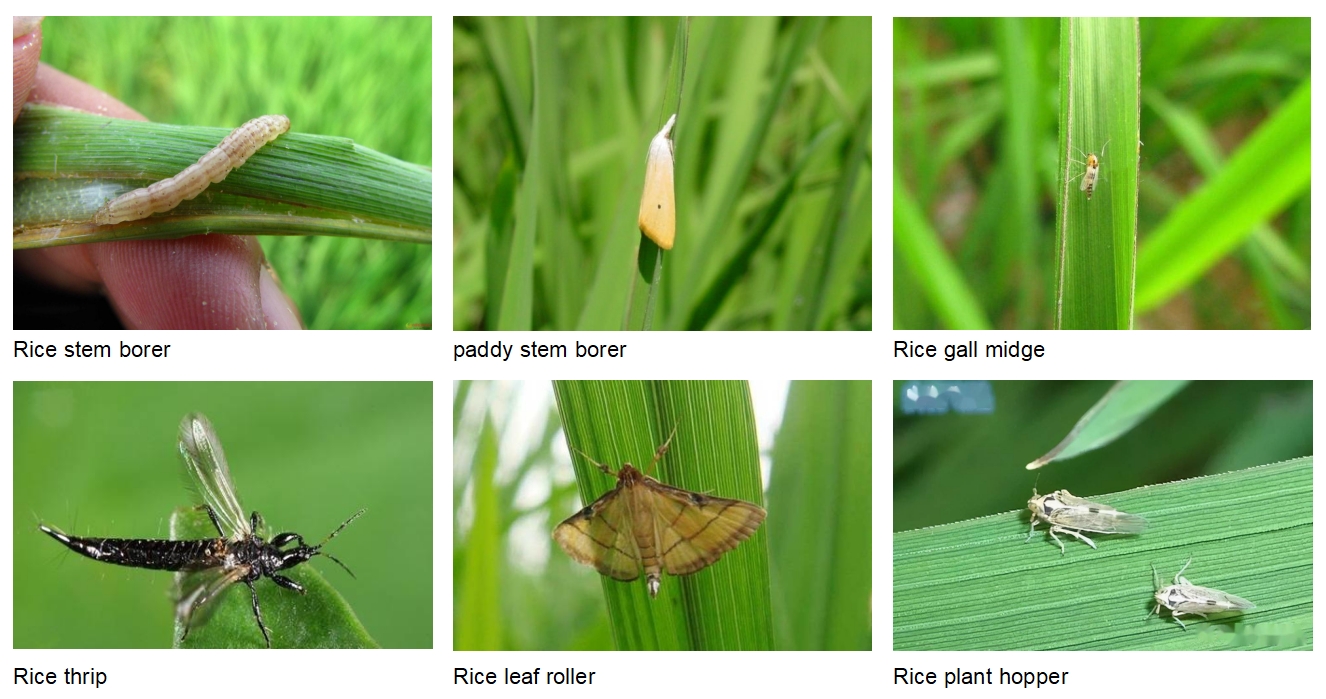
Apr . 29, 2024 10:51 Zurück zur Liste
What are the mainstream pesticides commonly used in rice?
In the process of rice production, nearly a hundred species of insect pests have been seen around the world. Among them, rice borers, rice leaf rollers, rice planthoppers, etc. are common, cause serious harm, and are difficult to control.
1.Common insect pests of rice
Lepidoptera: stem borer, paddy stem borer, rice leaf roller (boring on stems, chewing leaves, chewing mouthparts)
Homoptera: Rice planthoppers (brown planthopper, white-backed planthopper - often pierce and suck sap in the water layer and the base of the stem, with piercing-sucking mouthparts);
Diptera: rice gall midge;
Thysanoptera: rice thrips;

2.Commonly used pesticides for rice
**Nereistoxin insecticides
Common types: Bisultap, Monosultap, Cartap, Thiocyclam, etc.
Common points: Most of them are contact poisoning and stomach poisoning, with some fumigation and systemic inhalation (as the temperature increases, the fumigation effect becomes more obvious).
It has poor quick effect, but has a long lasting effect. Most of them have poor effect on rice planthoppers and are generally used to control borers. Cartap is effective against rice planthoppers.
**Antibiotic insecticides
Common types: Abamectin, Emamectin benzoate, Spinosad, Spinetoram, etc.
Common points: mainly stomach poisoning, intraosmosis, and contact killing. Generally, the insecticide speed is slow, but the duration of effect is long, and drug resistance is easy to develop. It is not suitable to be used multiple times a year.
Due to their good intraosmotic properties,Abamectin and Emamectin benzoate are mostly used to treat rice leaf rollers. (Has a certain effect on Homoptera rice planthoppers)
**Diazides
Common types: Methoxyfenozide, Tebufenozide, Chromafenozide, etc.
Common points: It is mainly contact and stomach poison, has special effects on Lepidoptera larvae, and has a certain egg-killing effect. It has a long lasting effect, good quick-acting effect, and is not prone to drug resistance.
Tebufenozide: Although very effective against lepidopteran larvae, it is highly toxic to aquatic organisms.
**Bisamides
Common species: Chlorantraniliprole
It is mainly stomach poisoning, has strong permeability, has a long lasting effect, but is relatively slow-acting, and has outstanding effects on young larvae. Resistance has developed in many places in my country, so it is recommended to be used in mixed formulation.
**Neonicotinoids
Common types: Acetamiprid, Thiamethoxam, Nitenpyram, Dinotefuran, Clothianidin, Thiacloprid, Flonicamid.
Common points: It is not only highly contact-killing, but also very systemic, and has a high control effect on homoptera. However, it is easy to develop resistance when used alone. It is often combined with Pymetrozine, which has strong systemic properties. The mode of action of Pymetrozine is to block the mouthparts of rice planthoppers, thereby slowing down the resistance to pesticides.
**Microorganisms
Common species: Bacillus thuringiensis, Metarhizium anisopliae, Mamestra brassicae multiple NPV, etc.
Common points: Bacillus thuringiensis is the main microbial product, and its relatively poor quick-acting effect. In order to compensate for its insecticidal speed, it is generally compounded with Abamectin and Emamectin benzoate (it cannot be mixed with alkaline pesticides, which will reduce the efficacy)
3.Recommended products
|
Product |
Form |
Target pest |
|
Chlorantraniliprole + Emamectin benzoate |
SC |
Rice leaf roller |
|
Chlorantraniliprole + Methoxyfenozide |
SC |
Rice stem borer |
|
Chlorantraniliprole + Dinotefuran |
WDG |
Rice stem borer |
|
Nitenpyram + Dinotefuran |
WDG/SG |
Rice planthoppers |
|
Chlorantraniliprole + Monosultap |
SC |
Rice leaf roller |
|
Chlorantraniliprole + Indoxacarb |
WDG |
Rice stem borer |
|
Dinotefuran + Indoxacarb |
WDG |
Rice stem borer |
|
Nitenpyram + Pymetrozine |
WDG |
Rice planthoppers |
|
Flonicamid + Clothianidin |
SC |
Rice planthoppers |
|
Dinotefuran + Thiamethoxam |
WDG |
Rice planthoppers |
|
Pymetrozine + Dinotefuran |
WDG |
Rice planthoppers |
|
Monosultap + Clothianidin |
GR |
Rice leaf roller/ planthoppers |
|
Chlorantraniliprole |
GR |
Rice stem borer |
-
Trusted Herbicide Suppliers For Large-Scale Crop Protection
NachrichtAug.20,2025
-
Overview Of Types Of Herbicides For Large-Scale Crop Protection
NachrichtAug.20,2025
-
Bentazone Herbicide Application in Field Crops
NachrichtAug.20,2025
-
Effective Fungicide Solutions For Large Scale Crops And Vegetables
NachrichtAug.20,2025
-
Effective Crop Protection With Insecticide Concentrate
NachrichtAug.20,2025
-
Thiamethoxam Half-Life in Soil and Water
NachrichtAug.04,2025
